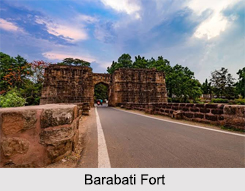 The Barabati Fort is an ancient fort of the 13th century build by the Ganga Dynasty at Cuttack in Odisha. It is located on banks of the River Mahanadi towards the North along with its distributary, the Kathajodi River towards the South. Out of all the tourist attractions of Cuttack, this happens to be one of the most sought after attraction because of its rich history. It is well known with a carved gateway 8 kilometres away from city. The location of the fort is in such a calculative place that it gives a spectacular and picturesque view of the modern Cuttack city.
The Barabati Fort is an ancient fort of the 13th century build by the Ganga Dynasty at Cuttack in Odisha. It is located on banks of the River Mahanadi towards the North along with its distributary, the Kathajodi River towards the South. Out of all the tourist attractions of Cuttack, this happens to be one of the most sought after attraction because of its rich history. It is well known with a carved gateway 8 kilometres away from city. The location of the fort is in such a calculative place that it gives a spectacular and picturesque view of the modern Cuttack city.
History of Barabati Fort
The construction of the fort started in 989 AD by the king Marakata Keshari. Initially the embankments on the shore of river Mahanadi was built to protect the city from floods and from there the idea of building the fort took its inception. Mukundadev Harichandan of the Chalukya dynasty, in 1560 A.D constructed a building of nine-storey in the confines of the Barabati Fort. Mukundadev Harichandan was the last Hindu independent king of the Odisha state who laid down his life fighting against Suleiman Karni, the Sultan of Bengal in 1568 A.D. During the 15th and 16th centuries, this Fort got safeguarded by two rings of forts on both sides of the Kathajodi River and the Mahanadi River. The city went to the hands of the Afghan rulers of Bengal in 1568 A.D., the Mughal Empire in the year 1592 and then to the hands of the Marathas in the year 1751. The British took control of Cuttack city along with the rest of Odisha in the year 1803. Cuttack was linked to Chennai and Kolkata by the Bengal-Nagpur Railways in the year 1919. The Cuttack city was made the capital of the newly formed Odisha state in the year 1936 and it served as a capital city till 1948 when Odisha`s capital was shifted to Bhubaneswar.
Architecture of Barabati Fort
The Barabati Fort`s ruins are still witnessed on the right bank of River Mahanadi, in the city`s western parts. One can now see an arched gateway and the mound constructed of earth, of the nine-storeyed palace. The Archaeological Survey of India has revealed that the Barabati Fort was approximately rectangular in shape with an area of about one hundred and two acres or more, and was encircled completely by a wall of sandstones and laterite. There is a tank to the western parts of the mound and to the north-east, are the remains of a previously existing temple. The temple was constructed by using whitish sandstone above laterite block foundation. Roughly four hundred fragments of mouldings and a few mutilated bits of sculptures have been recovered till now. This temple belonging to the Ganga period possesses an idol of Lord Jagannath made of stone. A mosque constructed by Nawab Murshid Quli Jafar Khan, who was a governor of the Emperor Aurangzeb, in 1719 CE can be seen there.
The fort of Barabati has undergone several makeovers from the time of its construction. The interior portions of the Barabati Fort have been changed into an arena, which is able to provide space for more than thirty thousand people at a time. Since its construction, it has been continuously serving as the site of various cultural events and sports tournaments. The Ganga dynasty bears a magnificent past over this glorious fort. The Barabati Fort has also seen the rule of several great dynasties.
Tourism in Barabati Fort
The Barabati Fort in the old Cuttack city of Odisha is unique of its kind and is now regarded as a heritage structure. At present, it sits right next to the modern Barabati Stadium which is the venue for various cultural and sports programme. A temple is also present nearby dedicated to the Katak Chandi, who is known as the presiding deity of the city.
Visiting information on Barabati Fort
This fort can be easily accessible from all prominent cities like Puri, Bhubaneshwar, Konark, Kolkata etc. There are trains available from all notable Indian cities to the Cuttack railway station, which is the closest railway station to the fort. The city of Cuttack is situated at a distance of 29 kilometers from Bhubaneshwar. National highway 5 passes through Cuttack city and the fort is conveniently located just 8 kilometers from the central parts of Cuttack. The nearest airport to the fort is situated in Bhubaneshwar and the suitable time for people to visit this fort is from the month of October to June.



















